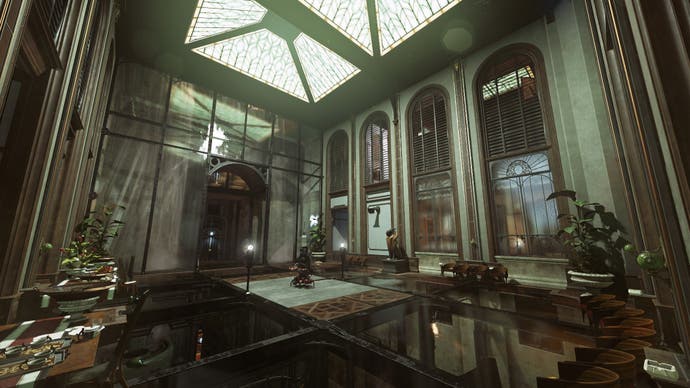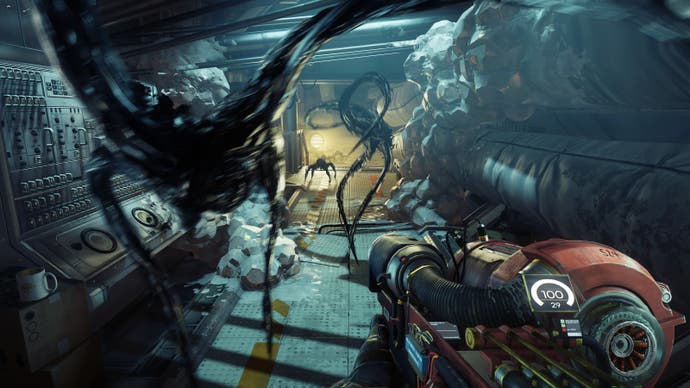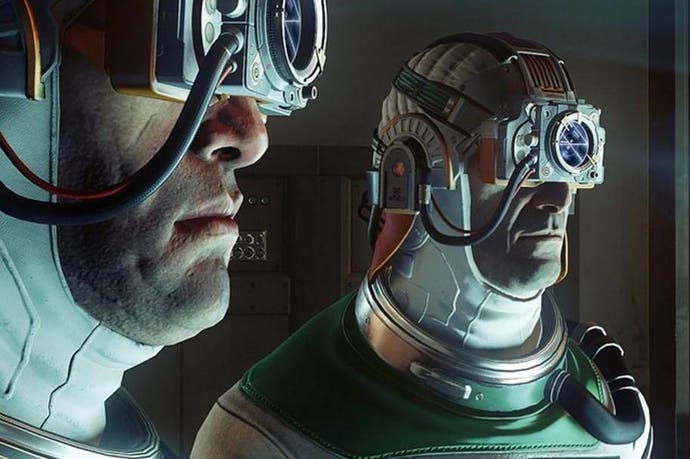Arkane's living prisons
Raphael Colantonio on Prey, Dishonored and breaking the world.
Arkane Studios is known as the developer of "immersive simulations" - worlds you sink into, wallow in, made up of intricately interlocking systems tied to exotic abilities, which can be manipulated to resolve a scenario any number of ways. But perhaps it would be more accurate to describe the Lyon and Austin-based company's creations as "emersive" sims, frameworks you struggle to break free of, using tools that aren't quite under the designer's control.
Just look at how they generally begin. Every Arkane title to date save for third-party licensed spin-off, Dark Messiah of Might and Magic, has opened with the player character in captivity - from the dingy jailhouse of the studio's 2002 debut Arx Fatalis to Emily's sealed bedchamber in Dishonored 2. It sets a certain tone, and while the Dishonored games ultimately cast you as a free-wheeling renegade, a rogue cell in the body politic, their stories and sandboxes are tainted by the knowledge that even the most open-ended piece of design is necessarily a form of entrapment, a set of cues and goads that insensibly guide or repel.

The streets of Dunwall and Karnaca may reward curiosity in ways a Call of Duty game never would, but they are still masses of baked-in vectors and scripted solutions, with lighted windows that tug at your attention, collectibles that lure you into the mouths of alleyways, villains whose various downfalls are woven into the terrain, waiting to be excavated. The real challenge of a game like Dishonored 2 - a challenge that informs every bit of developer discussion of its mechanics and variables - is accordingly to discover something, some tactic or access point, that Arkane hasn't anticipated. This is made explicit in the game's legendary Clockwork Mansion, a tacit interactive essay in which your adversary is essentially a malevolent level designer, tracking your route through his collapsing, reassembling laboratory much as publishers amass telemetry on player behaviour, till you slip the clutches of the critical path and turn the stage machinery against him.
"I think everybody likes to see what's on the other side of the décor," observes Raphaël Colantonio, Arkane's co-founder and president. "People like to go outside the boundaries, otherwise it just feels like 'oh, I know what you want me to do, game designer'. But as long as you can - not break the game in a way that is not fun, but break it in a way where you're like, 'oh, the game is still going, but I'm doing something that [wasn't planned for].' I feel special right now, because I'm doing something that is not planned - I think that's a great feeling for players."
In many ways, of course, the Clockwork Mansion is the greatest feat of deception of all - it sells the fantasy of liberating yourself, toppling the creator, within what is nonetheless an exquisitely choreographed and controlling piece of design. Eminently hateable though he is, the sociopathic Kirin Jindosh is little more than a consolatory metaphor, a prancing puppet-master to distract you from who is really pulling your strings. But if Arkane's gilded prisons are unbreakable, they are animated by a radical sensibility that is poorly served by critical paeans to "detail" or the mere quantity of meaningful choices a scenario supports.
If games are teaching mechanisms, Arkane's games teach you to distrust your teacher, to overthrow structures ostensibly put in place to aid or entertain. Much as the Dishonored games tell tales about the abuse of political power, so their levels are crucibles for activist tendencies that have a wider utility, to say the least. It's not just that they shatter the fourth wall, that much-abused grab for sophistication in fiction, or that they present you with landscapes that admit of more invention than in many games - it's that they reveal themselves for instruments of incarceration and encourage you, with varying degrees of gentleness, to break your restraints. Perhaps I'm going too far, but if I wanted to teach a course about institutions of oppression and the articulation of revolt in popular culture, I know which video games I'd bring to class.

Designing them involves no small expense and, as Liam Neeson would say, a very particular set of skills. "They're hard to make," says Colantonio. "There are a lot of invisible values in them, problems that people don't like to solve. All the possibilities - it's more about fixing a million problems than doing content. If you look at the effort that is poured into doing things to make it work, where if you were making some other kind of game you would not have to worry about it - what if the player does that? What if the player does this?
"Other games don't care about that and they get away with it, so I guess that might be one reason why people don't make these games so much. And secondly, I think they're hard to sell. I don't think publishers, other than Bethesda who really understand us because they've had their own success with this sort of game - I remember working with other publishers, and most of those values that are very inherent to immersive sims, most publishers are like: 'Why would you worry about that? Why do you care? What's the value? How does it sell the game?' I guess that's why they're rare."
It isn't just the moneymen who may fail to see the point of an immersive sim. Team members may take some convincing, even given a fondness for Arkane's previous work. "You definitely need a special kind of team," says Colantonio. "You need people who will trust you, because often they also go 'why do we waste time doing these kinds of things', or 'are you sure this is a good idea', and then eventually [they understand].
"We've had that in every game - when we recruit more people, some of them are really ready for this kind of game, but most of them they're not, so we have to tell them that you're going to do things that sometimes you'll have to redo, sometimes we'll throw them away. Some people are fine with that, and others find it too hard. And then at some point, those people realise that what they were actually working on, when it comes together - they realise why we do all this."

Integral to the development of an Arkane game is letting ideas for player abilities grow without respect for balance, allowing them to warp the structure of the game around them - Dishonored's Blink power, a teleport-dash which was originally one of the game's unlockables rather than a ubiquitous base ability, is a good example. Also integral to the development of an Arkane game is knowing when to stop, knowing when a system or tool is beginning to overwhelm the rest.
"I would say every game we've had problems like that," comments Colantonio. "I could go all the way back to Dark Messiah, with spawning frozen puddles on the floor and having people slipping on them, which was fun at first but then it would create situations where it just became ridiculous. We've had that all along.
"To find an example in one of the more recent games, Dishonored has a good one where by doing a double-jump plus a Blink, maybe combined with Agility, you could traverse a huge amount of space. We didn't really limit that - well, we did to some degree, we capped the momentum that you could aggregate, but we left it at a high value because we thought, 'eh, why not?' If somebody finds a way to access somewhere we didn't plan for, it's kind of cool, as long as it doesn't just break the game."
Arkane introduced a new generation to the concept of immersive simulation with the first Dishonored, reportedly exceeding internal expectations by a significant margin, though the sequel appears to have attracted fewer buyers for all its rapturous reception. The developer has also become more central to parent company ZeniMax Media's operations, taking on the Prey license after ZeniMax and publisher Bethesda fell out with original developer Human Head.
Arkane's re-interpretation of Prey began life in 2014 as a new IP, loosely inspired by the inter-connected dungeon of Arx Fatalis - set in 2032, it sees you touring a retrofuturist space station overrun by a range of formless aliens, including scuttling "mimics", reminiscent of Half-Life's headcrabs, that can assume the form of inanimate objects. It's a significant twist because it brings Arkane's taste for sumptuous, evocative period decor into conflict with its knack for systemic volatility - that faux-60s lampshade you're studying could be a mimic waiting to wrap its legs around your head.

"We don't decide what object they turn into, except at the very beginning of the game, because we want to introduce the mechanic to the player," notes Colantonio. "But at some point [in each area], there's an object that might be or might not be a mimic, and if a mimic is fighting you and escapes around a corner, it has a chance to turn into something. So if I play it and then you play the same area, it might not turn into the same object each time."
"We do set up some moments to fool the player - for example, put two of the same object somewhere, so that player might think 'ah, there are two trash cans, so maybe one is a mimic'. We do a little bit of that, but most of the time we just leave it to the simulation, and let the game do its thing."
Arkane doesn't stop there, however - over time the player will also acquire the ability to transform into (supernaturally and somewhat hilariously mobile) objects, a power that, as with those Blink combos, threw other parts of the game out of whack. "That was more of a nightmare for us, because if you're too small, you can fit into spaces, maybe access places we don't want you to access. So we've had some tuning to do there, defining how small an object we can accept the player to be, versus how big an object we can accept, and we've come up with some rules that feel consistent and fair."
I checked out a demo build of Prey shortly after speaking to Colantonio, and was immediately gripped, not least by the developer's ambivalent allusions to its prior work and the style of game it has kept alive. Buried in one email you'll find mention of Looking Glass Studios, the company behind the first Ultima and Thief games - foundation stones of the immersive sim genre that were an enormous influence on Colantonio and Arkane's co-owner Harvey Smith, in the days before they worked together.
The reference is more than an in-joke, I think. The in-game email chain in question concerns a part of the station that is essentially a glorified themepark ride - a positioning of Arkane's heritage within the new game's fiction that is difficult to read, but which I take for a reminder that every simulation, however lavish in its spread of possibilities, is another clockwork mansion at heart.
There's also a make of spanner named after Hephaestus, Greek god of artisans and craftsmanship - an ironic association for a tool that will serve you mostly as a bludgeoning implement. As with Arkane worlds in general, there's a sly provocation here, the suggestion that you might be able to do more with what you're given than is immediately apparent. Providing you have the imagination, of course, but more importantly, providing you actually want to be free.










